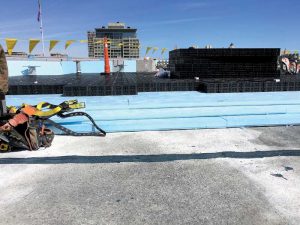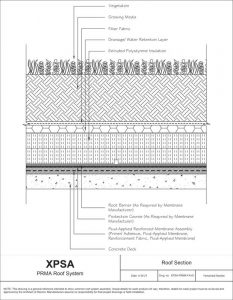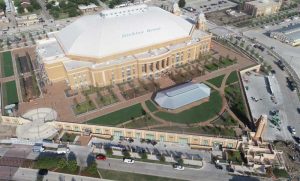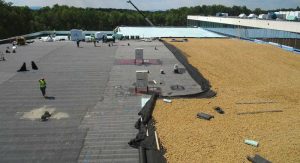
In roofing assemblies for low-slope concrete roof decks, protected membrane roofs set the bar for cost-savings, labor-efficiency, and roof life span among other advantages. These advantages may appear counterintuitive: Common sense suggests the roof’s waterproofing covering needs to be on top, protecting all the other components of the assembly from the elements of nature, including the insulation. Nonetheless, the primary moisture barrier (or waterproof roof covering) itself tends to be the weak link when exposed to environmental stresses.
When the waterproof membrane is on top of insulation, the relative expansion and contraction of the roofing assembly due to thermal cycling can be detrimental to roof longevity. Conversely, on a ‘typical’ roof, hailstorms and maintenance foot traffic both bear potential of mechanically damaging an exposed roof membrane. Additionally, the waterproofing membrane on top of the insulation can act as a vapor barrier, allowing moisture to accumulate in and around the insulation beneath the membrane, causing a whole different set of problems.
For these and many other reasons, protected membrane roofing assemblies are beneficial and desirable in modern building and construction.

Changing paradigms in roofing
The use of protected membrane roof assemblies (PMRAs) received a boost with the parallel developments of robust membranes that could support the weight of the assembly and water-resistant insulating materials. Fiberglass- or polyester-reinforced modified bituminous roofing membranes provide a seamless monolithic roof covering membrane that could last for many decades—especially when shielded from UV radiation and punctures. Coupled with boards of extruded polystyrene (XPS) insulation placed on top of such extremely durable, continuous, moisture-resistant roof coverings, the use of PMRAs gained acceptance among architects and construction specifiers.
According to a comprehensive account by Watts, in the early years of PMRAs, these roofs consisted of XPS insulation embedded in the flood coat of an asphalt built-up roof. This technology was quite successful in extending the service life of built-up roofs. By the 1980s, much was known about the performance of these ‘upside-down roofs’ which had the waterproofing membrane underneath the insulation rather than on top. Roofing materials were also changing. Modified bituminous roofing membranes were gaining in popularity. A new generation of these commercial roofing systems began entering the market under the PMRA designation. (see Figure 1)
A versatile roof

Aside from the obvious advantage of extended service life compared to traditional low-slope commercial roofing systems, PMRAs offer several other attractive features and benefits. Once the waterproofing membrane is installed, the building is sealed, and the building interior work can begin immediately. Concurrently, complex assemblies can be constructed on top of the building, tailoring the roof to the needs of the locality, as in the following examples (see Figure 2):
If the environ around the building behaves as an urban heat island, then the roof assembly can be designed to mitigate this effect. The urban heat island effect can be countered with a vegetative or landscaped roof or with the use of reflective materials for the top layers of the roof assembly;
If water runoff from sudden downpours is a problem in the building environ then a blue roof design may be desirable. The roof itself can serve as a water detention container;

A hybrid ‘green & blue’ stormwater management system allows some water to be captured by the roof and reused as non-potable ‘grey water’ for various suitable building needs, such as flushing toilets and watering lawns. This roof design reduces the demand from the water utility by repurposing water usage in areas where water conservation is important;
Occupiable roofs are also flourishing. There are countless designs for occupiable roofs with innovation abounding. Architects are only limited by their imagination. Occupiable roofs can be used for anything from rooftop dining and social gatherings to urban farming and recreational activities. High compressive strength extruded polystyrene (XPS) insulation competently supports occupiable roofs without compromising the performance of the roof assembly;




